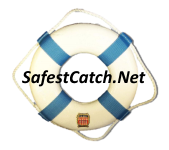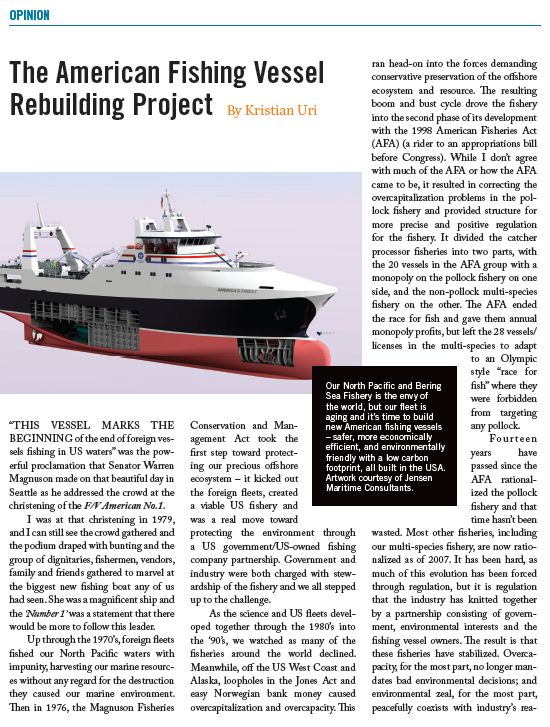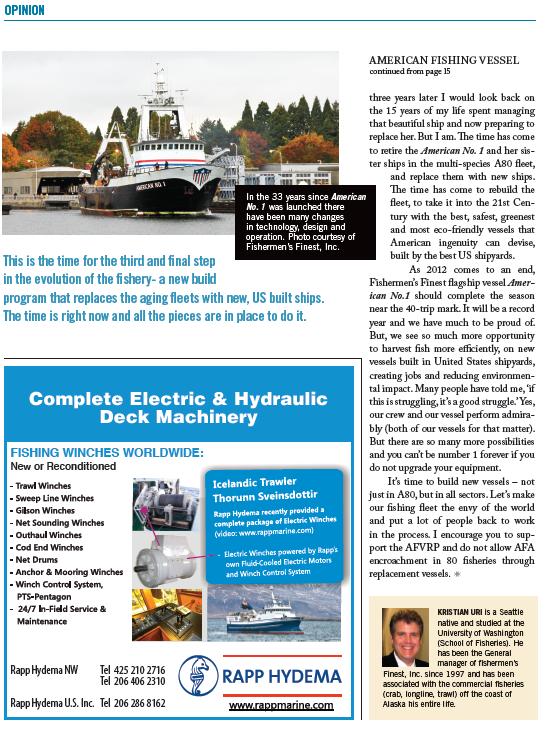About Safest Catch
SafestCatch.net is a web-based community committed to safety at sea and sustainable fisheries; Safety first followed closely by quality seafood production.
In a play on the imfamous Deadliest Catch, it is important to look beyond 'made for TV' and look at the real fishermen who are the true stewards of our Nation's resources.
Services
This site is envisioned as a go to source from one lifelong mariner's perspective to follow the maritime industry of the Pacific Northwest/Alaska and provide timely information on Safety Practices, Real World fishing in the North Pacific & Bering Sea, Training/Educational Links, Sustainable Stewardship of our Nation's resources, and more ~ check back regularly as the industry is 'all consuming' and there undoubtedly will always be something new to report on.
Log Book - AFVRP Kristian Uri
Safestcatch.net ~ Safest Catch dot Net
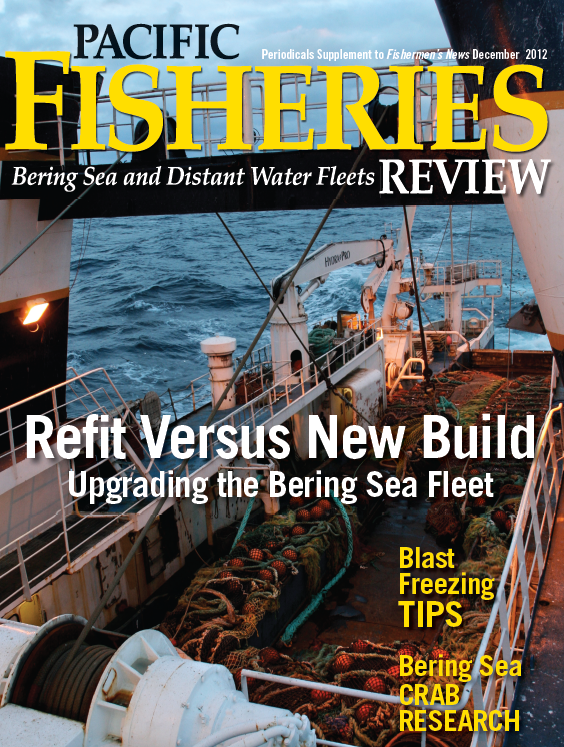
American Fishing Vessel Rebuilding Project by Kristian Uri - Pacific Fisheries Review December 2012
“THIS VESSEL marks the beginning of the end of foreign vessels fishing in US waters” was the powerful proclamation that Senator Warren Magnuson made on that beautiful day in Seattle as he addressed the crowd at the christening of the F/V AMERICAN No.1.
I was at that christening in 1979 and I can still see the crowd gathered and podium draped with bunting and the group of dignitaries, fishermen, vendors, family and friends gathered to marvel at the biggest new fishing boat any of us had seen. She was a magnificent ship and the ‘Number 1’ was a statement that there would be more to follow this leader.
Up through the 1970’s, foreign fleets fished our North Pacific waters with impunity, harvesting our marine resources without any regard for the destruction they caused our marine environment. Then in 1976, the Magnuson Fisheries Conservation and Management Act took the first step towards protecting our precious offshore ecosystem – it kicked out the foreign fleets, created a viable US fishery and was a real move towards protecting the environment through a US government – US owned fishing company partnership. Government and industry were both charged with stewardship of the fishery and we all stepped up to the challenge.
As the science and US fleets developed together through the 1980’s into the ‘90’s, we watched as many of the fisheries around the world declined. Meanwhile off the US West Coast and Alaska, loopholes in the Jones Act and easy Norwegian bank money caused overcapitalization and overcapacity. This ran head on into the forces demanding conservative preservation of the offshore ecosystem and resource. The resulting boom and bust cycle drove the fishery into the second phase of its development with the 1998 American Fisheries Act (a rider to an appropriations bill before Congress). While I don’t agree with much of the AFA or how the AFA came to be, it resulted in correcting the overcapitalization problems in the pollock fishery and provided structure for more precise and positive regulation for the fishery. It divided the catcher processor fisheries into two parts, 1) the 20 vessels in the AFA group with a monopoly on the pollock fishery one side, and 2) the non-pollock multi-species fishery on the other. The AFA ended the race for fish and gave them annual monopoly profits, but left the 28 vessels/licenses in the multi-species to adapt to an Olympic style “race for fish” where they were forbidden from targeting any pollock.
Fourteen years have passed since the AFA rationalized the pollock fishery and that time hasn’t been wasted. Most other fisheries, including our multi-species fishery, are now rationalize as of 2007. It has been hard, as much of this evolution has been forced through regulation, but it is regulation that the industry has knitted together by a partnership consisting of government, environmental interests and the fishing vessel owners. The result is that these fisheries have stabilized. Overcapacity, for the most part, no longer mandates bad environmental decisions and environmental zeal, for the most part, peacefully coexists with industry’s reasonable best efforts to achieve maximum sustainable, and environmentally sound, economic production from the resource. However the cost of this regulatory effort has been an effective prohibition on replacing the aging vessels, resulting in an unacceptable aging of the fleet. The average age of AFA pollock catcher processor hulls is 38 years and for the multi-species, non-AFA pollock catcher processers, it is just over 32.
This is time for the third and final step on the evolution of the fishery- a new build program that replaces the aging fleets with new, US built ships. The time is right, now and all the pieces are in place to do it. The last regulatory hurdle was solved with Amendment 97 in October, 2012 which, finally, allows the multi-species fleet to replace its vessels. The business models are stabilized after 5 years of rationalization in the multi-species fishery, so owners can prepare the reasonably reliable business forecasts required for taking on the massive new debt. At a time when the economy is demanding jobs, jobs, jobs, a new build program will create thousands of domestic highly skilled, high paying manufacturing jobs in the shipbuilding and offshore equipment sectors. The shipyards, owners and the crews are all ready to get started.
The problem is, however, the banks. While interest rates are at an all-time low and money is cheap for the banks, those advantages have not been passed through to the industry that needs the lending to borrow the money to start the projects that will get the economy going again. So we in the multi-species fishery came up with a solution: the American Fishing Vessel Rebuilding Project, the AFVRP. (See the details at our website, www.fishermensfinest.com)
The main objective of the AFVRP is to allow all fishermen (not just multi-species owners) to have access to long term loans that would encourage all vessel owners to build new vessels, cutting out the banking middlemen and getting the loans to finally flow to where they are needed. The program dovetails nicely with the current consensus in favor of fiscal stimulus to jump start the economy and domestic manufacturing. It’s a win-win-win solution. Sure, there are some who are not excited to see this happen and are trying to kill the new build program in its crib through a new round of regulation they recently initiated at the North Pacific Fisheries Management Council. The AFA pollock monopoly has its sights set on replacing our sector’s 32 year old hulls with their retiring 38 year old hulls instead of new builds. But we are confident that the Council will quickly decide to do what’s clearly best for the fisheries, the crews, the fleets, the shipbuilders and the environment, and the country, even if it does prevent the AFA monopoly from making a few extra bucks profit on top of their existing monopoly profits.
Our North Pacific and Bering Sea Fishery is the envy of the world, but our ships are not. Our fleet is aging and it’s not hard to imagine that in the 33 years since the American No. 1 was launched, there have been a few technology changes in vessel design and operation. Beautiful, state of the art, safe, seaworthy, green foreign vessels are being built in Europe with the support of their governments. We envision new American fishing vessels- safer, more economically efficient, and environmentally friendly with a low carbon footprint, all being built in the USA. The AFVRP will help us achieve our vision and help put the country back to work, rebuilding the fleet and our manufacturing base at the same time.
That day at the Marco yard with Senator Magnuson, I was 13 years old. I never could have imagined that thirty three years later I would look back on the 15 years of my life spent managing that beautiful ship and now preparing to replace her. But I am. The time has come to retire the American No. 1 and her sister ships in the multi-species A80 fleet, and replace them with new ships. The time has come to rebuild the fleet, to take it into the 21st Century with the best, safest, greenest and most eco-friendly vessels that American ingenuity can devise, built by the best US shipyards.
As 2012 comes to an end, Fishermen’s Finest flagship vessel American No.1 should complete the season near the 40 trip mark. It will be a record year and we have much to be proud of. But, we see so much more opportunity to harvest fish more efficiently, on new vessels built in United States shipyards, creating jobs and reducing environmental impact. Many people have told me, ‘if this is struggling, it’s a good struggle.’ Yes, our crew and our vessel perform admirably (both of our vessels for that matter, but as this is an article on the American No.1, I am focusing on her). But there are so many more possibilities and you can’t be number 1 forever if you do not upgrade your equipment.
It’s time to build new vessels – not just in A80, but in all sectors. Let’s make our fishing fleet the envy of the world and put a lot of people back to work in the process. I encourage you to support the AFVRP and do not allow AFA encroachment in A.80 fisheries through replacement vessels.
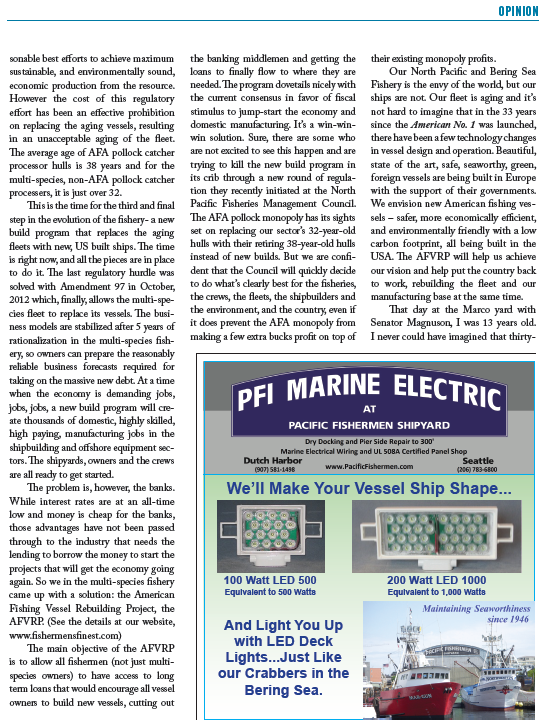
Make way for American No.1 to lead to America’s Finest Permanent Link: AFVRP
